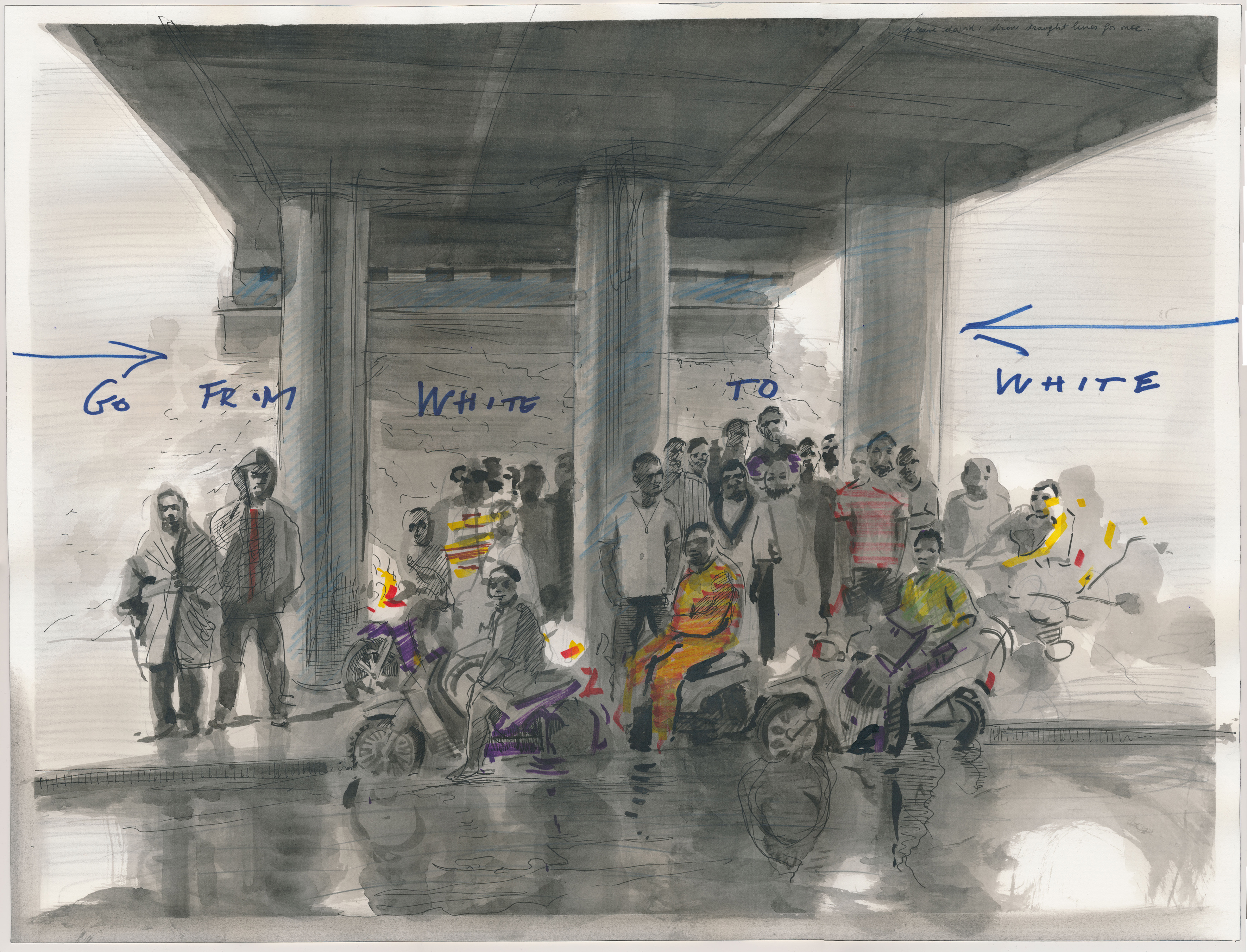
Oil Workers (From White to White), 2013
Drawing Time: On David Claerbout’s Notations of Presence
Christian Viveros-Fauné
McMonagle, Christine/Sean Kelly Gallery (eds.), 'David Claerbout. Drawings and studies. With an essay by Christian Viveros-Fauné', Hatje Cantz Verlag/Sean Kelly Gallery, 2015, ill.
Time, one can imagine the artist David Claerbout saying, is a state of mind. An artist who has spent decades illustrating the duration of images, he has become best known for his eye-and-mind-bending film projections and installations. These basically stretch and compress time like a rubber band. The result of highly deliberative investigations that begin with the history of images—his work includes drawing, painting, photography, film and computer-generated imagery (CGI)— Claerbout’s pictures seek to unlock a secret inside simple human perception: the unstable nature of time.
Mining the space between direct experience and the parallel universe of picture-making technologies, Claerbout has explored frozen moments throughout his oeuvre that, in his words, establish the existence of a “third kind of material” that lives “in your head.” This “material,” according to Claerbout, is located somewhere between phenomena the eyes can see and occurrences the mind can’t grasp without machines. On observing this perceptual gap, the artist has conspired to make existential time visible. Like a latter-day Muybridge, Claerbout’s pictures freeze movement; yet the Belgian artist also imbues still images with glacial change—while underscoring the uncanny effects this kind of dreaminess engenders.
Trained as a draftsman, a lithographer, and a painter, Claerbout first became interested in exploring the idea of time through his investigations of painting as tableaux—a medium he has referred to fittingly as “an old kind of cinema.” Those explorations were subsequently followed by the artist’s study of the essential properties of still and moving images. An artist who eschews realist Newtonian physics where things occur in sequence, Claerbout has learned to craft visual riddles that take as their starting point Henri Bergson’s idea of duration: inner time as experienced by individual subjects. Partly in an effort to ground what appear to be airy metaphysical discussions, Claerbout has also relied substantially on drawings—art making’s most elementary kind of images.
Though Claerbout has never previously exhibited his drawings, these works have become fundamental to the artist’s layered working method. Not storyboards in any conventional sense, his highly detailed sketches serve an essential stocktaking function. Rather than employ illustrations to launch sequential narratives, Claerbout’s handmade images give pause to what is, at bottom, a profoundly reflective process. “Mostly made,” in the artist’s words, “before the completion of the work, not often after,” Claerbout’s drawings are composed as crucial visual meditations. Thoughts cast in the form of deliberative marks, they make material problems, insights, and solutions arising from the artist’s strange mission: namely, his repeated efforts to make extended time-based works from still images.
If storyboards have a clearly streamlined industrial purpose—the form was originally developed at Walt Disney Studio in 1930—Claerbout’s drawings function more like maps drafted in the heat of travel. Examples include the heavily annotated pictures the artist made while producing his celebrated work “Oil Workers (from the Shell company of Nigeria) Returning Home from Work, Caught in Torrential Rain.” A deceptively complex HD video animation that finds its genesis in a single jpeg of more than two-dozen men sheltering beneath a highway overpass, Claerbout’s elaborate installation required him to periodically cast back to first principles. The drawings resolve basic questions about the work’s direction; additionally, they helped him evaluate how to “get things back together.” Another question Claerbout asked himself while turning to pen and paper: “Why did I make this piece in the first place?”
For Claerbout, the act of drawing has long functioned as concrete time-stopper, a visual and conceptual cornerstone from which to rejig the scaffolding of his highly abstracted artwork. As the artist tells it: “For ‘Oil Workers’ I started with a simple picture from the internet, a very small teeny-tiny picture, and I made this entire production which is very expensive and took one full year to make. At the end of that production, I no longer knew what I was doing. Like a forest, it overgrew out of my head, and I had to make drawings to rediscover why I did some things.”
A similar relationship emerges between Claerbout’s drawings and many of his other finished installations. Consider, for instance, the five sketches Claerbout made while working on the single channel work “Travel.” A video constructed entirely from CGI, “Travel” uses advanced computer technology to a plot an entirely fictional journey from a nondescript park to a dark European forest to a teeming Amazon jungle to emerge, finally, into a nondescript suburban plain. Scored by relaxing synthesizer music, the artist’s swooping video recalls the kind of intense but generic cinematic experience routinely encountered at Imax theaters. The drawings, on the other hand, couldn’t be more specific. Among other written indications, Claerbout’s illustrations of ersatz natural environments specify “counterlight and main light” as recurring themes, while making explicit the cathedral-like feel animating the video’s swelling penultimate sequence.
Much like his increasingly sophisticated videos, David Claerbout’s drawings use art’s oldest technology to arrive not at the truth of perception, but to confront reality with a relentless set of questions. Among these are: What do we mean by time? Is movement an illusion? And, if time is truly held by the observer, can sequential art be made from images with no actual duration? Claerbout’s films provide answers in the form of consistent conundrums, while his drawings provide practical descriptions of basic metaphysical mysteries. In this process Claerbout’s works on paper are more than mere tools—they achieve notations not only of time but of presence.
David Claerbout ©2026